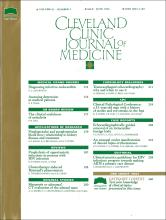ABSTRACT
BACKGROUND Various antineoplastic agents can cause Raynaud's phenomenon, as can malignant diseases themselves.
OBJECTIVE To review the clinical characteristics of chemotherapy- induced Raynaud's phenomenon and compare them with those of malignancy-associated Raynaud's phenomenon.
SUMMARY Chemotherapy-induced Raynaud's phenomenon most commonly occurs in patients with testicular cancer who receive bleomycin either as a single agent or as part of a multipledrug chemotherapeutic regimen. It tends to resolve spontaneously, especially after discontinuation of the inducing antineoplastic agent, and rarely causes significant functional impairment. However, it tends to recur with subsequent administration of the drug. In contrast, malignancy-associated Raynaud's phenomenon is rarer, causes more severe symptoms, and usually occurs in older patients with more advanced cancer.
CONCLUSIONS As more patients with cancer undergo chemotherapy, physicians should be aware of the potential delayed toxic effects of antineoplastic drugs.
- Copyright © 1994 The Cleveland Clinic Foundation. All Rights Reserved.






